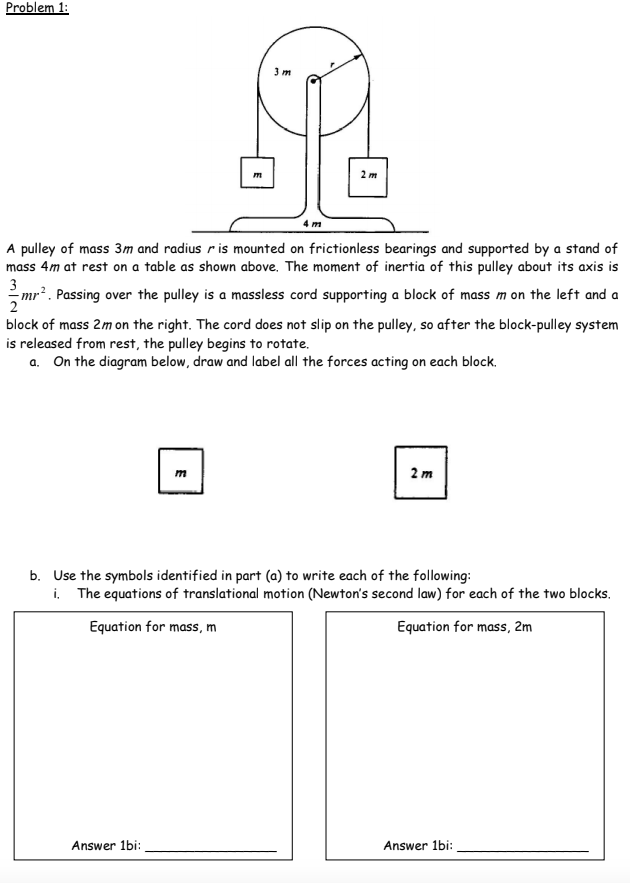A pulley of mass 3m and radius r is mounted on frictionless bearings and supported by a stand of mass 4m at rest on a table as shown above. The moment of inertia of this pulley about its axis is 3/2*m*r^2. Passing over the pulley is a massless cord supporting a block of mass m on the left and a block of mass 2m on the right. The cord does not slip on the pulley, so after the block-pulley system is released from rest, the pulley begins to rotate. a. On the diagram below, draw and label all the forces acting on each block. b. Use the symbols identified in part (a) to write each of the following: i. The equations of translational motion (Newton’s second law) for each of the two blocks. Equation for mass, m. Answer 1bi: ________________ Equation for mass, 2m. Answer 1bi: ________________ ii. The analogous equation for the rotational motion of the pulley. Answer 1bii: ________________ c. Solve the equations in part (b) for the acceleration of the two blocks. Answer 1c: ___________ d. Determine the tension in the segment of the cord attached to the block of mass m. Answer 1d: ___________ e. Determine the normal force exerted on the apparatus by the table while the blocks are in motion. Answer 1e: ___________
A pulley of mass 3m and radius r is mounted on frictionless bearings and supported by a stand of mass 4m at rest on a table as shown above. The moment of inertia of this pulley about its axis is 3/2*m*r^2. Passing over the pulley is a massless cord supporting a block of mass m on the left and a
block of mass 2m on the right. The cord does not slip on the pulley, so after the block-pulley system is released from rest, the pulley begins to rotate.
a. On the diagram below, draw and label all the forces acting on each block.
b. Use the symbols identified in part (a) to write each of the following:
i. The equations of translational motion (Newton’s second law) for each of the two blocks.
Equation for mass, m.
Answer 1bi: ________________
Equation for mass, 2m.
Answer 1bi: ________________
ii. The analogous equation for the rotational motion of the pulley.
Answer 1bii: ________________
c. Solve the equations in part (b) for the acceleration of the two blocks.
Answer 1c: ___________
d. Determine the tension in the segment of the cord attached to the block of mass m.
Answer 1d: ___________
e. Determine the normal force exerted on the apparatus by the table while the blocks are in
motion.
Answer 1e: ___________

Trending now
This is a popular solution!
Step by step
Solved in 4 steps with 1 images
